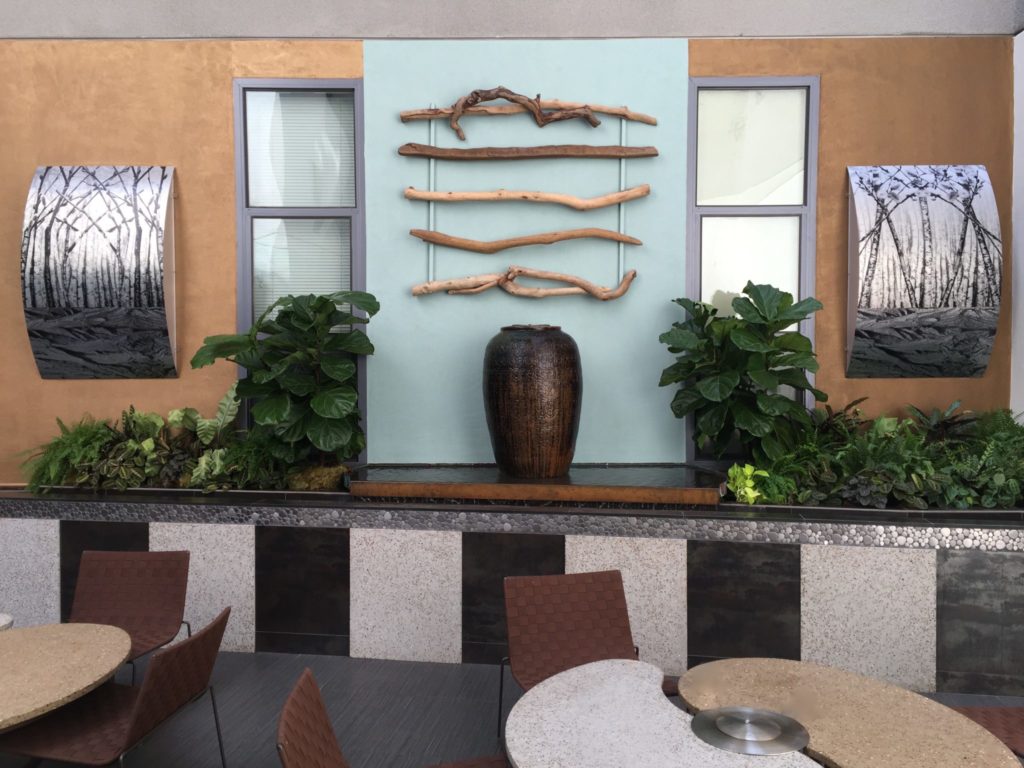The contemporary design index leans toward comfort that is personalized, practical, and pleasurable. People want to feel a part of their environment and to be included in its raison d’etre.
Today most people don’t care as much about impressing others, or being impressed, they care about being surrounded by a nurturing spatial continuity that makes them feel relaxed and revitalized. Whether this is at home, work, or in a public space, this continuity fulfills the modern psychological need for place identity; a form of visual branding that creates a sense of comfortable and usable familiarity.
The newest architectural/spatial concepts amalgamate unusual and re-purposed or green materials into public art, eco art installations, and the creation of total environments. The goal is to develop functional spaces that evoke specific emotional responses and produce connection to the environment in a non-ordinary way. Integral to the process is the effective combination of three dimensional and two dimensional design elements which produce genius loci or “spirit of place”. Materials such as cast glass and concrete, ceramics, wood, and papier-mâché are replacing the plastics and factory veneers of the 20th century. As integrated design solutions that resolve spatial challenges, these practical, aesthetic elements bond and organize a space into a cohesive whole. Through strategic color placement, pattern coordination, and the use of sculptural elements, sensual fulfillment merges with efficiency.
Also an awareness of spatial psychology, known as proxemics, plays a huge role in the architectural and design choices that are being looked at and implemented today. Proxemics is a concept that describes our spatial awareness in both social and literal contexts. An example would be our spatial comfort zone when we are speaking to a stranger; which is both cultural and personal. It also applies to good or bad feelings that can arise in a space based on factors like having enough room to move as opposed to feeling closed in. Good design works with this human (and cultural) need for harmonious spatial effects. This is achieved through scale, placement of design components, room height and width, and actual spatial modifications. However, it is also accomplished with hue and color placement, textures, and art work. Art that is integrated into the environment, from finishes to complex imagery, fulfills a deep spatial need; especially when it is personalized as nurturing and/or truly relevant to the function of the space.
Awareness of spatial relationships and how they affect us through architecture, color, art, and the use of non-traditional resources and materials, is the key to creating compelling and efficacious design in the 21st century.
As Jane Parkins wrote in her February 2012 article:
“The success of a space, public or otherwise, relies for the most part on the atmosphere that it creates for the user. While functionality is always a key part of design, if individuals feel uncomfortable in the space; its functional aspects are simply wasted”.
Martha Channer /MC2 The Science Of design
MARTHA CHANNER is co-owner of MC² The Science of Design, an interior design company that specializes in custom design, space planning, and fine art installations.www.mctwodesign.com.
She received her BFA in painting and printmaking, with a minor in Art history, from Barat College in Illinois. She also attended The School of the Art Institute of Chicago, where she studied spatial design, sculpture, and paint applications. She is a performance artist, fine art painter,and choreographer, which she incorporates into her large scale installations and exhibitions. Her work is shown nationally in galleries and museums. www.marthachanner.com


